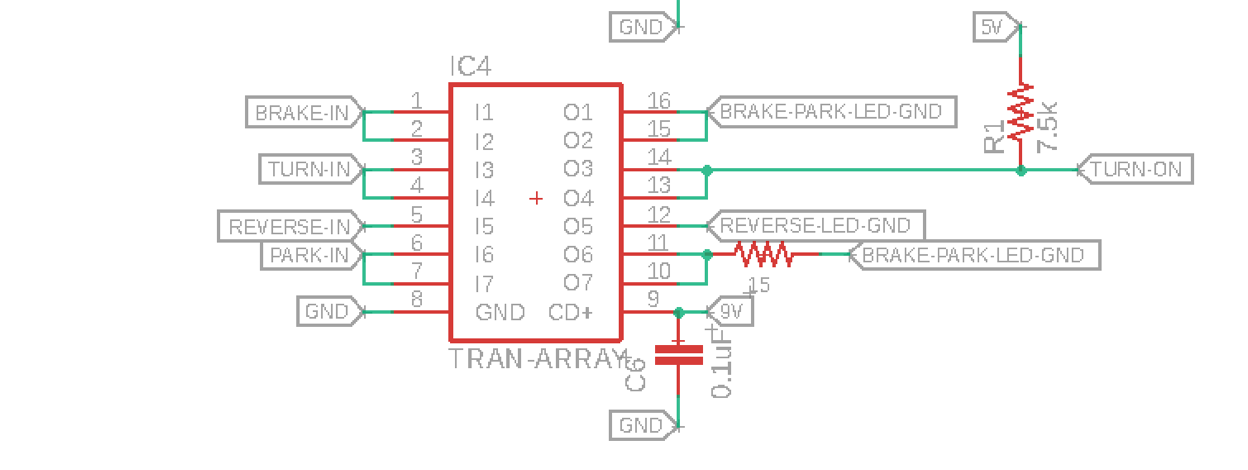Application We have chosen the Texas Instruments TPL7407LA to drive groups of LEDs for an automotive lighting solution. The TPL7407LA inputs are connected to +12 VDC input signals to trigger the TPL7407LA’s outputs to turn on. These outputs are sinking current from groupings of automotive LEDs through the TPL7407LA.
INPUTS
BRAKE-IN +12VDC signal from vehicle's mechanical brake switch
TURN-IN +12VDC signal from vehicle's electronic flasher switch OR thermal hazard switch (depending which is enabled)
REVERSE-IN +12VDC signal from vehicle's mechanical reverse switch
PARK-IN +12VDC signal from vehicle's mechanical headlight switch
GND Vehicle's ground
COM Connected to 9V rail. 9V rail is also providing power to LED groupings.
OUTPUTS
BRAKE-PARK-LED-GND (O1/O2) LED common ground from brake light LED grouping
TURN-ON Connected to micrcontroller pin. Pullup resistor to 5V rail installed to preventing floating. 5V rail also connected to microcontroller power supply pin.
REVERSE-LED-GND LED common ground from reverse light LED grouping
BRAKE-PARK-LED-GND (O6) LED common ground from brake light LED grouping. Resistor inline used to dissipate power and ultimately lower LED grouping's brightness.
Issue When applying power to the TPL7407LA on the test bench, the TPL7407LA inputs and outputs work just as expected. Power from the test bench is supplied by a generic adjustable power supply set at 12.5 VDC in this scenario. The TPL7407LA sinks a maximum of approximately 1.0 A total when all inputs into the TPL7407LA are activated with the given +12 VDC inputs.
When installing our product on a vehicle, testing goes mostly as expected except for the scenario where more than one of the +12 VDC inputs into the TPL7407LA goes high. The vehicle provides the switched +12 VDC power input triggers via mechanical OEM vehicle switches (brake light push button switch, turn signal electronic flasher, hazard thermal flasher, etc).
We notice that when multiple transistor are activated (typically from both the brake and the turn +12 VDC signal inputs), then after the lines are deactivated - upon the next activation of the lines, all outputs are activated no matter which singular transistor is activated. I believe this is a symptom of a damaged transistor array and we are unsure why this condition is occurring.
We have since ordered an automotive grade ULQ2003AQDRQ1 equivalent to see if this part is more resilient than the TPL7407LA for this application, but it is still very bizarre to us why this transistor array would be damaged in this type of environment.
What are we doing incorrectly in this application that is causing damage to this transistor array?

